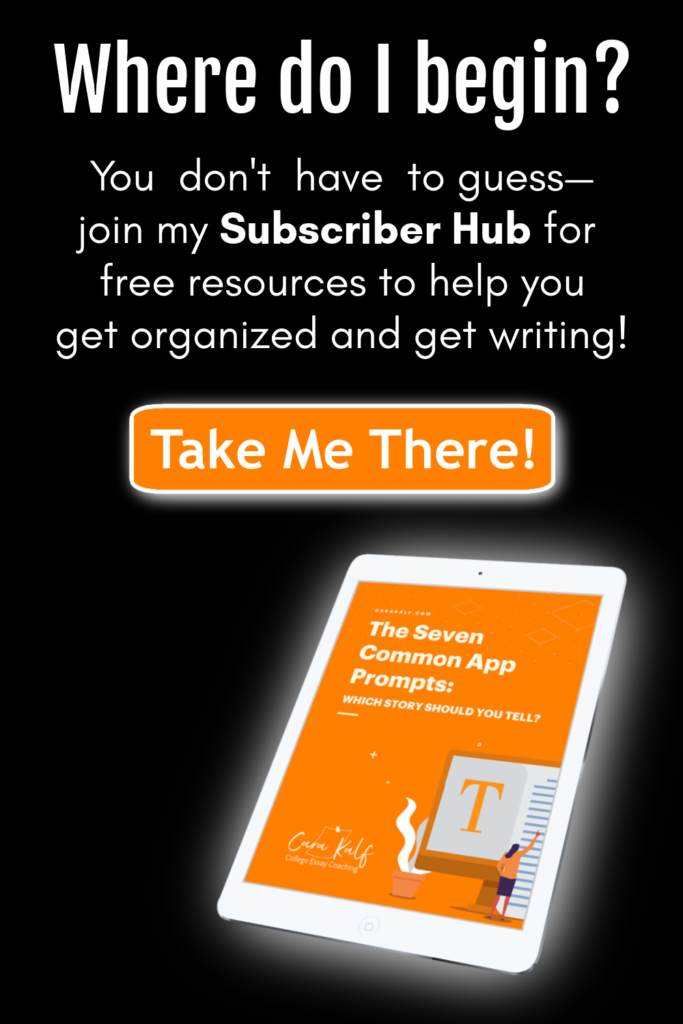The college application process could not encourage procrastination more effectively if that were its explicit design. The deadlines are months and months away, the process is confusing, the number of tasks seems to be constantly expanding, and on the whole—it’s dull. The reward is almost a year away and not even guaranteed. Really remarkable that anyone can get started, isn’t it?
The process is overwhelming, and the temptation to procrastinate can be almost overpowering, whether you have a “neurotypical” brain or a brain with ADHD. But brains with ADHD have an extra hurdle: They are motivated by interest rather than importance. No amount of reminders about how important college applications are in the long term will change the ADHD brain’s lack of motivation to get started. If you’re a student with ADHD (or a parent of such a student), the application process might feel plain impossible.
So I’ve done my homework and gathered some great advice from several books about succeeding with ADHD—and I’ve applied that advice specifically to the admissions process. There are tricks and techniques at every step of the way that will make a difference, and I’m going to walk you through each one. To be even more ADHD-friendly, I’m tackling the process one chunk at a time. Today, we’re just getting started.
Stop Procrastinating, Part I: Cut the Overwhelm
One of the most common causes of procrastination for all students—but especially students with ADHD—is when an assignment feels large and undefined. We’re going to start by breaking this process down into chunks, and from there into lists, and from there into tiny steps, each so small that you’ll be a lot less tempted to procrastinate when you could just get it done.
You can use whatever list-making tool you prefer, paper or digital. If you haven’t got a preference, I’m going to recommend the free web-based tool Trello. Not only can you easily make groups of tasks, see the entire process visually, move tasks from group to group, and share your lists with one or more accountability buddies—you can actually just copy my templates to get started. (If you prefer paper and pencil or another app, feel free to copy what I have in whatever way is most helpful to you.)
Decision-Making Made Easier
ADHD brains can struggle with decision-making, and the first chunk of the application project is making a college list. We’re going to use some great advice from ADD-Friendly Ways to Organize Your Life, by Judith Kolberg & Kathleen Nadeau, to make this step more clear and less stressful. Once you’ve gotten over these initial hurdles, choosing schools can be one of the fun parts of the process.
Kolberg and Nadeau explain that decision overwhelm can lead to impulsive choices to “get it over with,” or passive “decisions-by-default” like eliminating choices by procrastinating until deadlines have passed. “The best way to avoid decision overwhelm is to limit the input,” they write. They recommend “fencing in your hunting ground” when you’re trying to make a decision, forcing yourself not to get lost in the options. This is the perfect metaphor for the college search. There are many, many, many schools out there—more than five thousand in the United States alone—and the feeling that you must evaluate each for the best fit will make you crazy. Don’t do that to yourself.
If you expect to comb through every school to find your perfect match, you’re going to procrastinate. I’m going to suggest several “fences,” or limits, you can put on your college list to give yourself permission to simply ignore long lists of schools that aren’t right for you. Now, if you’re committed to being a Varsity athlete or majoring in a subject that has limited standout programs, those priorities will help you limit your options. For everyone else, however, I recommend using all of the “fences” below—or at least most of them—in order to gradually narrow your search to only the best-fit schools.
The Geographical “Fence”
The most literal “fence” is geographical, drawing a border around an actual area or areas that you want to attend school. I’ve written before about the many reasons that the geographic location of your college is surprisingly important. [In a new window, open this blog post and read it later. It’s pretty important for this college-selection stage.] Given that most areas have dozens, if not hundreds, of colleges, the geographical fence is a great choice to make first. Now you are freed from looking anywhere except your top geographical choices.
The Budget “Fence”
This limit was a suggestion in the book for any kind of decision, and its importance goes double for the college decision. If you or your parents aren’t paying for Harvard no matter what—then cross it off and move on. Be smart about potential aid and scholarships. Talk with your guidance counselor, and make sure you’ve considered all of your possibilities. But when you’ve figured out how much you can budget for tuition, fees, room and board; how much you can reasonably expect to get in aid; and how much you’re willing to owe when you graduate; then choose an outer limit for tuition and make it a fence. There is no sense falling in love with a school you can’t afford.
The “Numerical Limit”
This advice also comes straight from the book, and again is excellent advice for the college search. In order to avoid giving yourself too many choices, simply choose a number of applications you’re going to complete, and stop looking when you have that many schools on your list.
Consider the classic breakdown of “safety” schools, “match” schools and “reach” schools. Choose a number from two to five in each category. Let the total number of schools be between 8 and 12. (I chose those numbers based on my work with students and then checked around to make sure I was in line with other admissions professionals. I was surprised that we were all pretty much in agreement, suggesting that a carefully chosen list of this size will serve you well.)
This is a great time to take an honest look at your abilities and your record. Talk with your guidance counselor and use library resources to outline what kind of scores and acceptance rates would indicate safety, match and reach for you. There’s no sense taking time to apply to colleges that are far outside of your ability level. It’s a waste of limited resources. (Your college application energy is a limited resource. Treat it as such.)
Personally, I’d go for three safeties, four matches, and one to three reaches, depending on how much I loved those reach schools and how far of a stretch they realistically were. If my “stats” made me a reasonable candidate for reach schools and I were willing and able to pay for them, I would go for more—but don’t waste your application energy on schools you want to get into, only on ones you want to go to. If making a list of 12 reaches makes you feel overwhelmed and like you won’t do any of them—then be strict with yourself. Set all of these limits for yourself before you even start looking.
Keep in mind that any school with an acceptance rate under 20 percent should realistically be considered a “reach,” even if your outstanding test scores and GPA make it a perfect “match” for you. An acceptance rate that low means that hundreds of qualified candidates are rejected every year.
This is also a good way to keep finding your ideal safeties in mind as part of the overall process. It’s not a safety if you won’t actually go there, so give as much attention to choosing these two to five schools as you give to the reaches.
Above all, though, remember that this is going to be your school—not your soul mate (if you believe in that sort of thing). There is not one right school waiting out there for you to discover it. There are several good possibilities. I have written before that I loved my undergraduate experience and wouldn’t change it—yet I also find exciting programs and opportunities at other universities every time I’m working with students. You will have plenty of great options!
Today’s To-Dos
Here is where we break things down into short, doable actions steps. Most ADHD brains work best under time pressure, so set yourself mini-deadlines at least once per week.
- Read this blog post about how Trello can help you get organized.
- Sign up for my free Subscriber Hub to get access to my Trello boards.
- Make your own copies of the boards and start adding to-dos and colleges of interest (anything you already have in mind).
- Print or download the “College Personal Ad” worksheet at the Subscriber Hub. Paper or tablet, you need to be able to fill it in.
- With your College Personal Ad open beside you, read the in-depth blog post on what you should be looking for in a school. When you get a new idea of something to look into about potential schools (Orchestra? Service club? Type of dorms?) make a note.
- Set yourself a deadline of no more than two weeks to get that CPA completely filled in. Remember, this is the stuff coming out of your head and your heart, not things you need to research.
- With your parents or other invested party, set your Budget Fence. If that’s something you need to think about, have your parents choose a date by which you will collectively make this decision. Have them help you make a list of things you might need to do before pinning down this number (investigate scholarship opportunities, start FAFSA, etc.).
- With your parents, set your numerical limits. Download your College List from the Subscriber Hub and set it up with your ideal breakdown of safety, match and reach.
- Set a reminder on your phone to come back here in two weeks for the second installment of Admissions & the ADHD Brain!
You want your application to stand out. Click Here Now
(Photo by Braden Collum on Unsplash)


